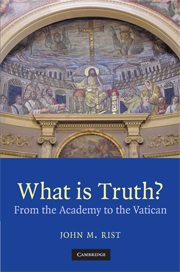Book contents
- Frontmatter
- Contents
- Acknowledgments
- Abbreviations
- Introduction: Partial and universal truth
- 1 The human race, or how could women be created in the image and likeness of God?
- 2 Divine justice and man's “genetic” flaw
- 3 Divine beauty: Nature, art and humanity
- 4 The origin and early development of episcopacy at Rome
- 5 Caesaropapism, theocracy or neo-Augustinian politics?
- 6 The Catholic Church in “modern” and “post-modern” culture
- 7 Looking at hopes and fears in the rear mirror
- Bibliography
- Index
4 - The origin and early development of episcopacy at Rome
Published online by Cambridge University Press: 05 June 2012
- Frontmatter
- Contents
- Acknowledgments
- Abbreviations
- Introduction: Partial and universal truth
- 1 The human race, or how could women be created in the image and likeness of God?
- 2 Divine justice and man's “genetic” flaw
- 3 Divine beauty: Nature, art and humanity
- 4 The origin and early development of episcopacy at Rome
- 5 Caesaropapism, theocracy or neo-Augustinian politics?
- 6 The Catholic Church in “modern” and “post-modern” culture
- 7 Looking at hopes and fears in the rear mirror
- Bibliography
- Index
Summary
Quis custodiet ipsos custodes?
JuvenalTHE RELEVANCE OF THE PRESENT THEME
In the contemporary “global village” in which a new and more or less autonomous Christian church or community is formed almost every minute, the Roman Catholic Church could not survive intact without a dogmatic (hence indirectly cultural) centre. That centre is provided by the Roman see, the principal reason why the “Western” Church, unlike Orthodoxy, has thus far not fragmented further. By fragmentation I refer not merely to the existence of autonomous (or autocephalous) churches but (as with Anglicanism) of autonomous doctrines. To make that case as strongly as possible would require a book on the history of the see of Rome – which for both practical and intellectual reasons I could not now write – to show how its gradual emergence as the ultimate doctrinal centre of Catholicism has inhibited the disintegration of Christianity, as well as entailing its own development not only as a doctrinal but also as a juridical centre. What I can manage, within the limits of the present chapter, is an argument that the doctrinal role of the Roman see – amid other often more vigorously intellectual local churches – had already begun to emerge in the early centuries, though, of course, the development was by no means complete. Nor, humanly speaking at least, was it yet irreversible. Yet a pattern had been set which others, from both more and less sympathetic viewpoints, have shown to have continued to the present day.
- Type
- Chapter
- Information
- What is Truth?From the Academy to the Vatican, pp. 201 - 232Publisher: Cambridge University PressPrint publication year: 2008

